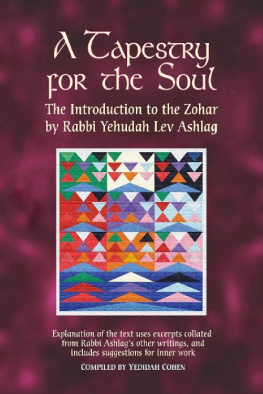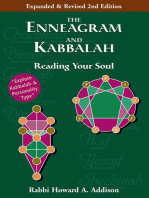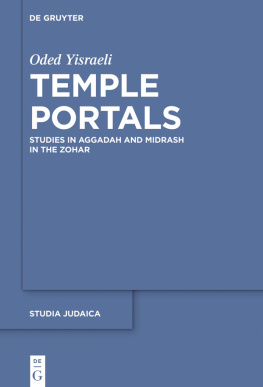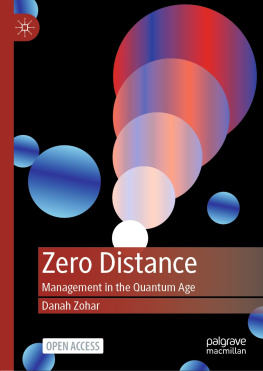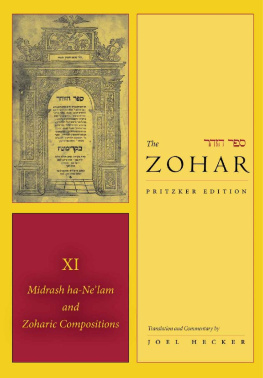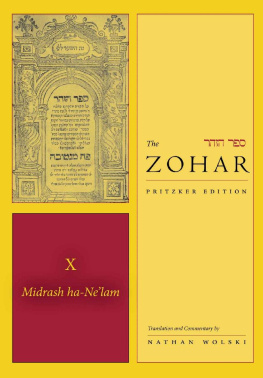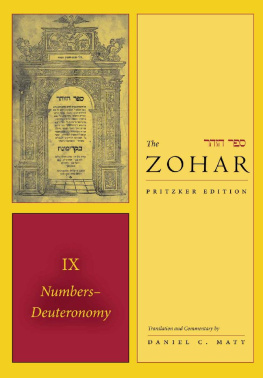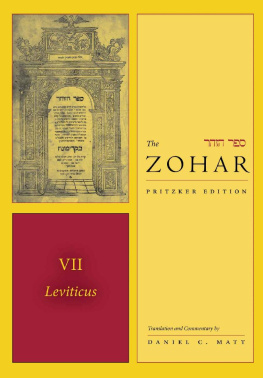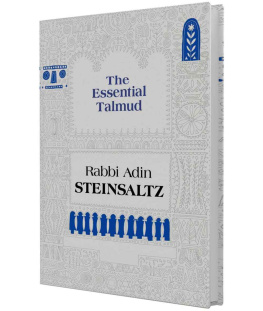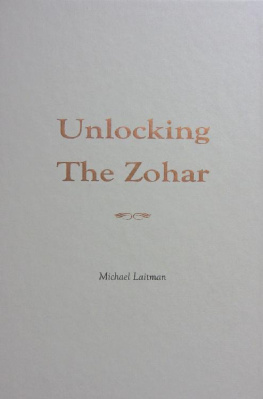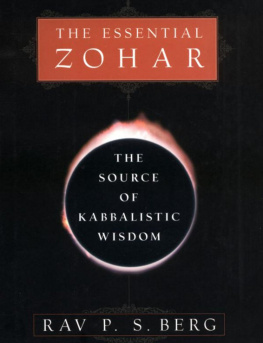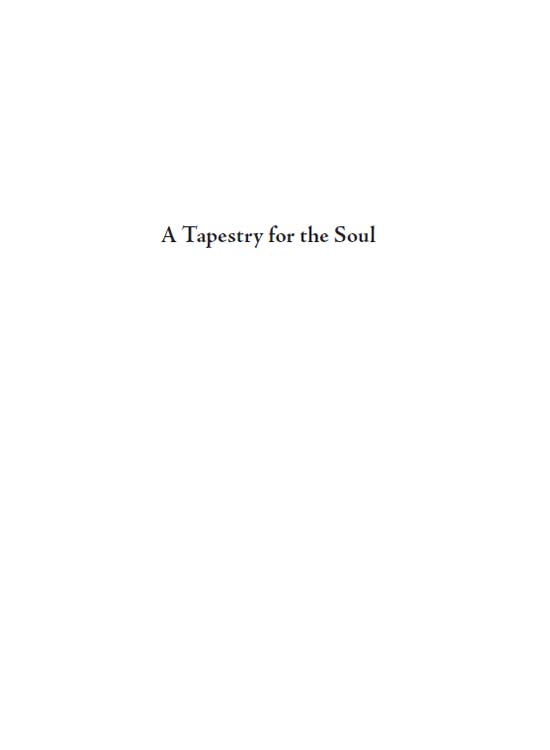
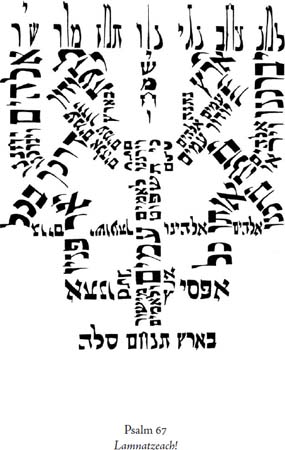
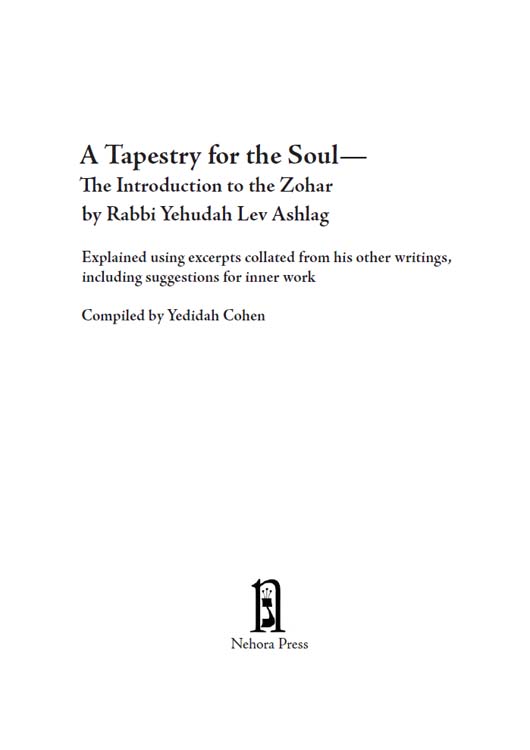
Publisher:
Nehora Press:
P.O.Box 2586,
Har Canaan, Safed 13410 Israel
tel: 972-4-6923254
email:
www.nehorapress.com
Yedidah Cohen 2010
First edition Printed in USA
(Translated from Maarag lNeshamahHakdamah leSefer haZohar meet haRav Yehudah Lev Ashlag)
ISBN 9789657222041
Printed on acid-free paper from sustainably managed forests.
Library CIP data:
Ashlag, Yehudah.
A tapestry for the soul-- the introduction to the Zohar: explained using excerpts collated from his other writings, including suggestions for inner work / by Rabbi Yehudah Lev Ashlag; [trans. and] compiled by Yedidah Cohen.-- 1st ed.
p. : ill. ; cm.
Includes a translation of: Maarag leNeshamah: Hakdamah le-Sefer ha-Zohar.
Includes bibliographical references and index.
ISBN: 978-965-7222-04-1
1. Ashlag, Yehudah. Hakdamah le-Sefer ha-Zohar. 2. Zohar--Criticism, interpretation, etc. 3. Cabala. I. Cohen, Yedidah. II. Title. III. Title: Hakdamah leSefer haZohar. English.
BM525.A59 A7735 2009
296.1/62
For the reader: There are holy Names of God printed in this book. Please be mindful to treat the book respectfully, not taking it into the bathroom or leaving it on the floor.
for Mark
and for
Shahar
May their holy memories inspire us
and be for us a blessing
Contents
Preface
When you pick up a book your questions are: What is this book? Who is it for?
This book is a study guide to a key text in Kabbalah, the Introduction to the Zohar by Rabbi Yehudah Lev Ashlag, as published in English in In the Shadow of the Ladder. It is for the student of Kabbalah who wants to learn directly from Rabbi Ashlag himself, without any intermediary. It is for the student who wants to use Kabbalah as it is meant to be used; as a tool to explore who we are, what are our souls deepest desires, and what we are here in this life for.
You may ask, Do I need any prior knowledge to use this book? Not really. In principle it is self-contained. That said, I have to confess it is a book you are going to have to ponder over, discuss with your friends, read several passages more than once, argue with, consider, reconsider, write in your journal, and dialogue with. You may need to send me email questions, if and when you get stuck. You may wish to join or form a study group on this bookseveral have already formed prior to the books publication in Englishor you may wish to read it on your own.
A Tapestry for the Soul is a compilation of Rabbi Ashlags work taken from a wide variety of his writings, arranged to accompany the on-going text of the Introduction to the Zohar, such that Rabbi Ashlag himself is teaching the Introduction. I would like to point out that this work is compiled but not edited; it really is Rabbi Ashlag who is the teacher. Here is authentic Kabbalah.
Most of the book consists of texts by Rabbi Ashlag, the twentieth century Kabbalist successor to both Rabbi Shimon Bar Yochai, the author of the Zohar, and to the Ari, Rabbi Isaac Luria, the author of the Etz Chayim (Tree of Life). However, I have included suggestions for journal work as an aid to seeing connections between the writings and our individual lives.
Should you read In the Shadow of the Ladder first? Both books have their place and are not similar to each other. In the Shadow of the Ladder may be compared to an overall view of a wood, A Tapestry for the Soul may be likened to focusing on some of the trees. The books may therefore be read or studied in any order. Hopefully, by the time you have finished A Tapestry for the Soul you will be well equipped for any further reading in the field of Jewish Kabbalah. Material you may find useful, including material that deals with how to apply the wisdom of the Kabbalah in our lives, may be found on the Nehora Press website. Equally, your insights, questions, and sharing of experiences, are all welcome. For those wanting to start a study group, there is special guidance available through the web-site.
Having myself been privileged to study the work of Rabbi Ashlag, it is my greatest pleasure to try and convey to you something of my own experience and excitement as I explore the different threads that make up the vast tapestry of his work.
With all my blessings that our learning should bring benefit to all humanity,
Yedidah Cohen
Acknowledgements
My husband Mark lived to read the first draft of the completed book in the original Hebrew, Maarag lNeshamah, and I felt his presence throughout the books writing.
I would like to thank my mother, Chaya Goodman, whose never-failing support has been crucial for this project. I would also like to thank Larry Loewenthal, Sary Manor, and Reuven Goldfarb for their editorial suggestions, Avraham Loewenthal for the generous donation of his art work and his ongoing enthusiasm, and Professor Michael Dickel for his thoughtful input on the journal work.
I would especially like to thank my English-speaking chevrutas and groups who show me how much they need authentic translations of Rabbi Ashlag in English.
Finally I would like to thank my sons Yigal and Asaph and my daughters Binah and Brachah who, day in and day out, show their support for this work by their patience, love, and understanding.
There are no words at all to express the debt of love and appreciation we all owe to the Masters Rabbi Yehudah Lev Ashlag and Rabbi Baruch Shalom haLevi Ashlag, may their holy memory be for a blessing. Working on this material brings me again and again back to the beginning, back to the question, Who am I? I give thanks to the Almighty for the incredible privilege and grace He has bestowed upon me of allowing me this precious task of bringing this holy wisdom to others.

Note to the Reader: I have done my best to deal with the gender issue relating to him and her. I respect the feelings this issue arouses. However the original texts were mostly written using the masculine gender only, and continually translating he as he or she proved to be either cumbersome or ungrammatical. I have had to come to a compromise: I have used he or she occasionally where possible, to remind us all that the work applies to both genders, but otherwise I have used he as referring to both genders. It is clear from the below quotations that the creation of the human being, his and her spiritual development and complete rectification, depend upon us all, male and female alike.
This is the book of the generations of Adam. On the day that God created Adam He created him in the image of God. Male and female He created them and He blessed them and He called their name Adam on the day of their creation. (Genesis 5:1-2)
Adam (Man) is both male and female and is not called Adam except with the inclusion of both. (Zohar)
He created them male and female and He called their name Adam. Each one alone is only half a body and is not called Adam. (Perush haSulam
Next page
